Idaho Panhandling, Hell’s Canyon
No, we’re not begging, we’re panhandling. It’s different — when you’re in the Panhandle. Here’s how:
You know you’re in the North when the local Home store has the entire front walk lined with log-splitters.
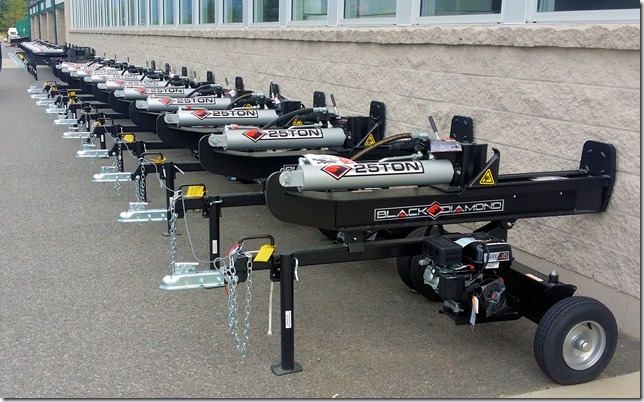
You know you’re in horse country when there are entire aisles dedicated to lariats, tack, and horseshoes of every size and shape.
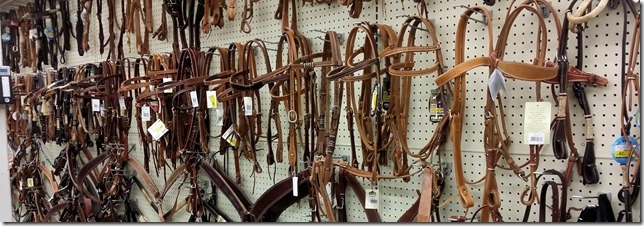
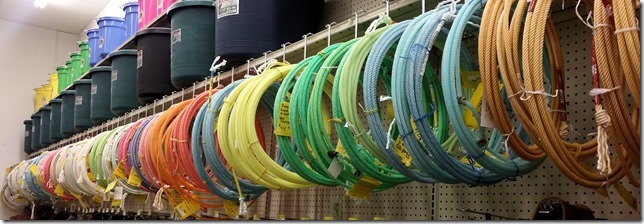
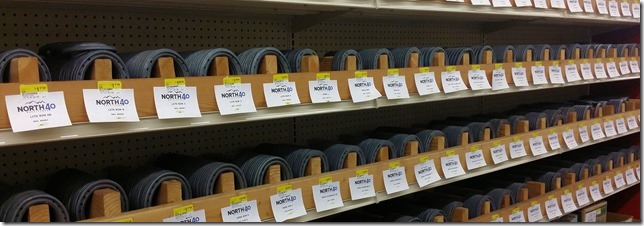
And you know you’re in hunting territory when the rows of guns disappear into the haze, and you can get a ready-made, six-foot-diameter, eight-foot-tall, fiberglass oak-tree hunting blind for a mere $3799.

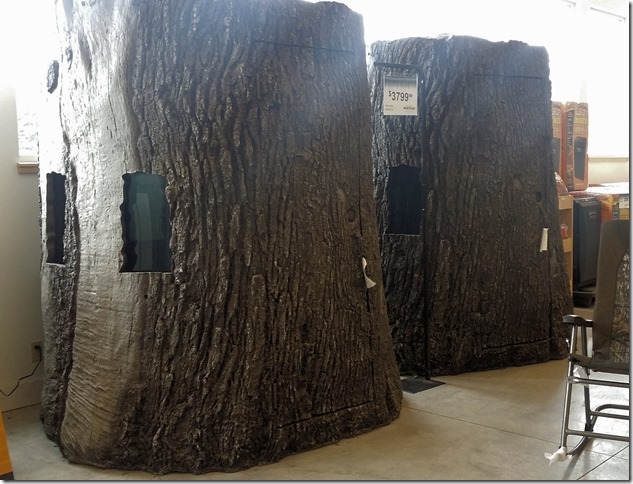
We were in IDAHO. I have it on good faith that this is actually one of the United States, but it clearly is also part of another planet. I wandered through the store, awed and mesmerized by off-the-shelf goods that I’d never in my life seen before in any store. Assortments of hydraulic rams and drive-shaft yokes. Forty yards of gas-cans, all without the infernal insanity of draconian California CARB spill-spouts. Another forty yards of work gloves. Simply amazing.
There were other touches of the bizarre that introduced us to this unusual State. Here’s a front yard decoration near our campsite in Sandpoint: eye-catching, don’t you think? The tame wild turkeys and deer in the neighborhood seemed to enjoy it.
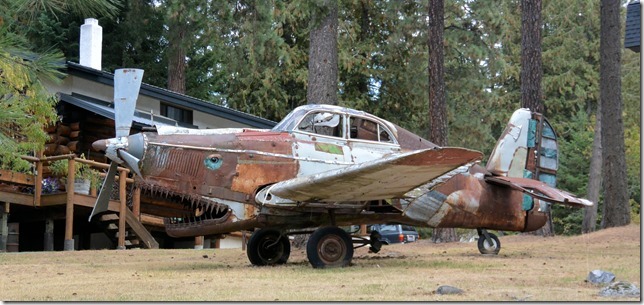
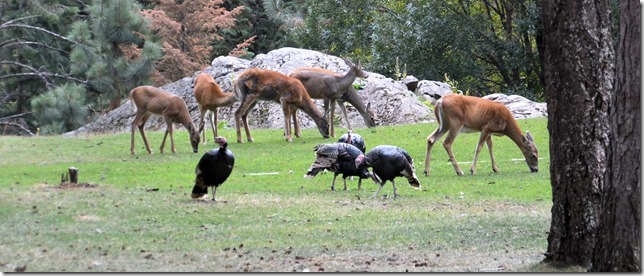
This is simply and purely an outdoorsman’s place – – –
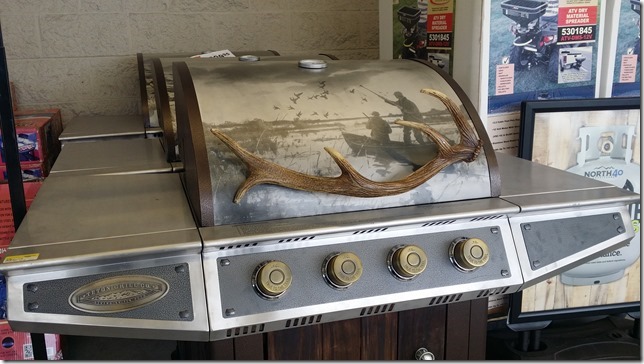
But we weren’t in the Idaho panhandle for tame turkeys or rusty airplanes. We were there to see and explore the Hell’s Canyon area.
On the border of Idaho and Oregon runs the Snake River, and it’s been flowing there for a long, long time. Its flow has, in fact, cut down through thousands of feet of hard, igneous rock to create the deepest river gorge in North America. Yes, deeper than the Grand Canyon by 50%, about 7,800 feet deep compared to the 5,000 or so at the Big One. Not as colorful, and certainly not the same tourist draw, but well worth “stopping off” on our way back from Canada.
This is a view from Sheep Rock overlook on the Idaho side. Hell’s Canyon drops down below the overlook, to the hidden Snake River below. In the far distance is the ridgeline of Oregon’s Wallowa mountains.
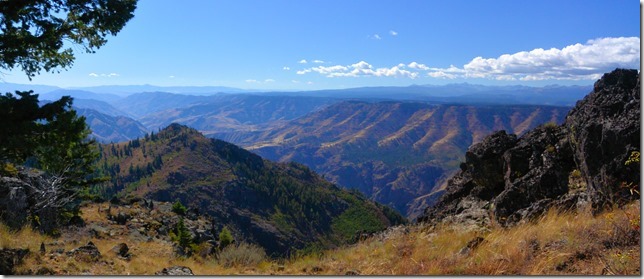
Near the top of Idaho, the forests are indistinguishable from Canada’s and the border is the only differentiator. But a little bit further south and Idaho has enough flatlands to engage in some serious farming and ranching.

Near the southern end of this farming/ranching area, Lewiston lies with its Washington sister Clarkston, self-proclaimed gateways to Hell’s Canyon, straddling the confluence of the Clearwater and Snake rivers.
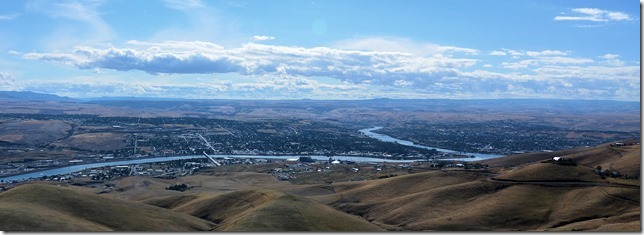
Below Lewiston, we passed through Grangeville, a beautiful farm town northeast of Hell’s Canyon on our way to our first camp. Its outlying fields reminded me of Dorothy’s Kansas. Grangeville is one of those rare towns with no crummy section. The whole place was trim, well-kept, and presented as if the residents were proud of it.

There was a gorgeous steam-tractor on display near the small museum – – –
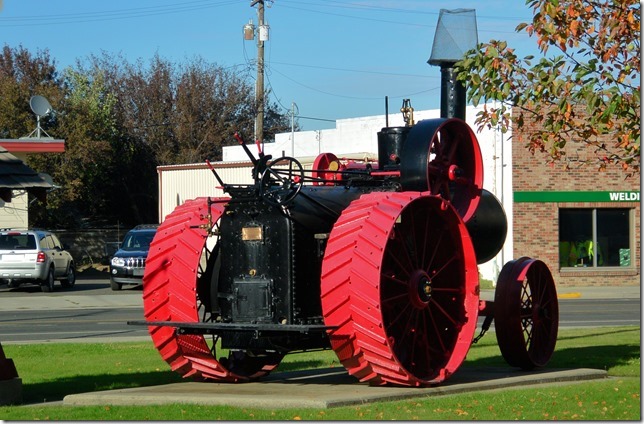
– – – and a really nicely-done cemetery stretching for several blocks, each headstone with a view to the setting sun. Quite symbolic.
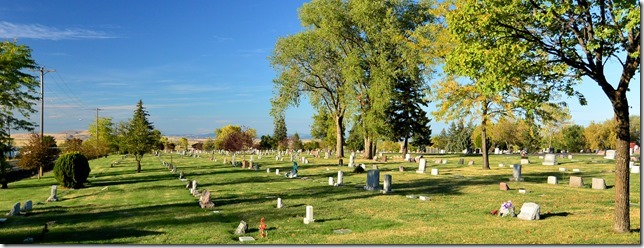
Farther still, and the mountains rise up and forests dominate the landscape again. Our camp was actually on the Salmon River, not the Snake, because we thought the Idaho side would be the best approach to Hell’s Canyon. In fact, there are better approaches, access, and camps on the Oregon side – but Idaho has its offerings as well.
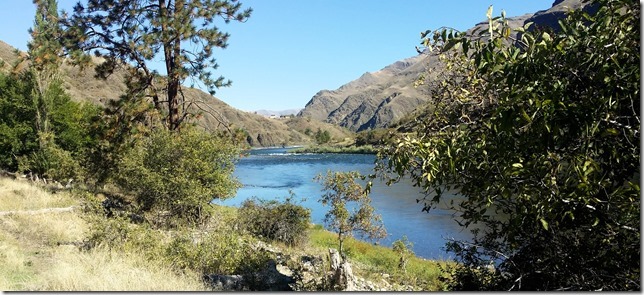
The Salmon was nice, but we still wanted to get near the Snake, so we took Ralph on a side trip to Pittsburgh landing. This was a place where rafters on the Snake, having put-in at Hell’s Canyon Dam, would be picked up after a 4-5 day river trip. It was about a 20-mile dirt road from our camp, diving deep into the heart of the Canyon.
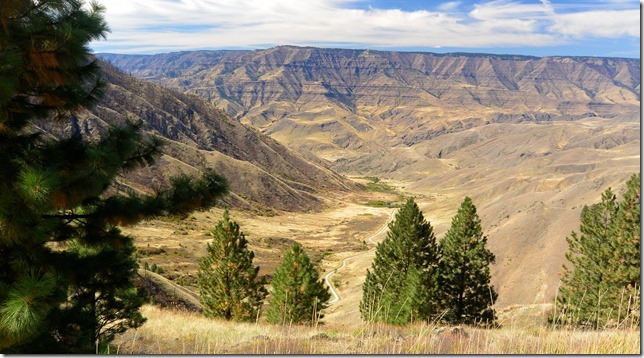
We did see some rafters come into the area, paddling slowly through this more-placid area (there are class-III rapids or worse upstream).
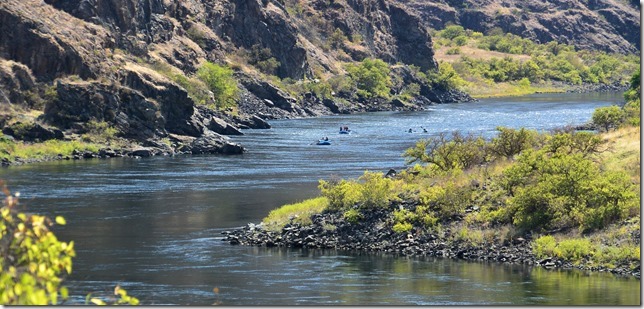
This is a part of the Canyon where it’s easy to see the ruggedness that gave it its name.
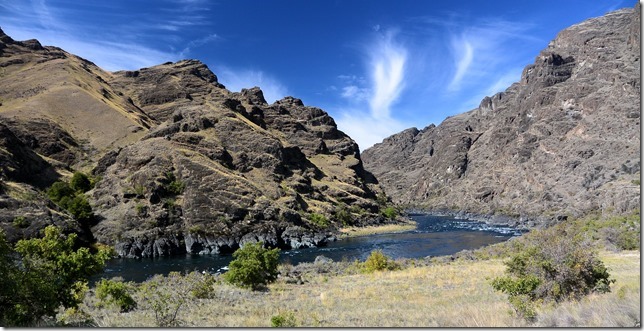
And we got a real treat up away from the landing, where a group of Bighorn sheep calmly munched field daisies while I snapped my Nikon at them. At first, they were quite far off, and we thought we’d only get a binoculars’ glimpse.
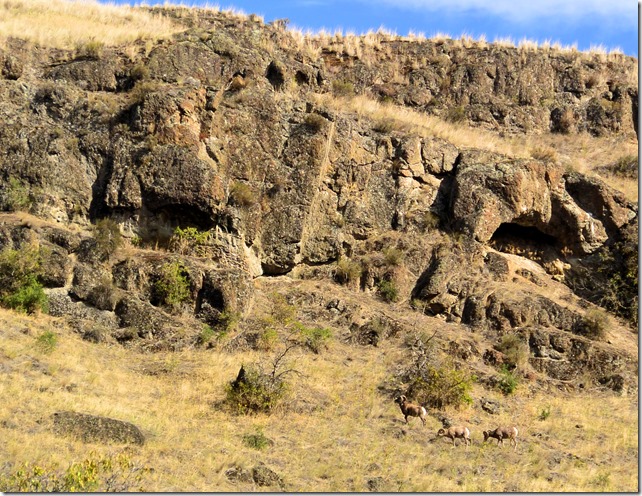
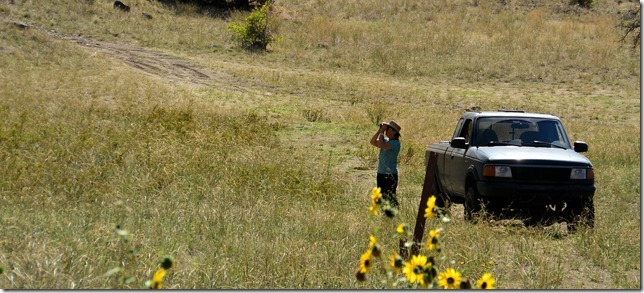
But they were amazingly tolerant of my presence, and I managed to approach them within 50 yards or so before they started to move away.
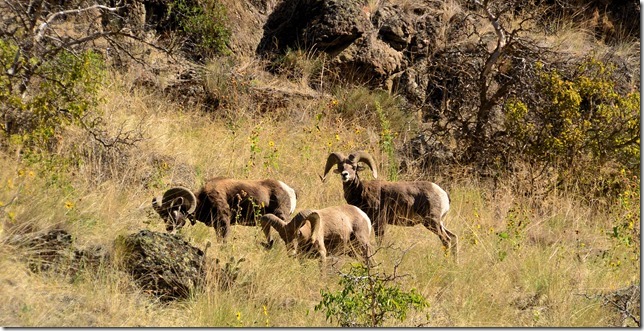
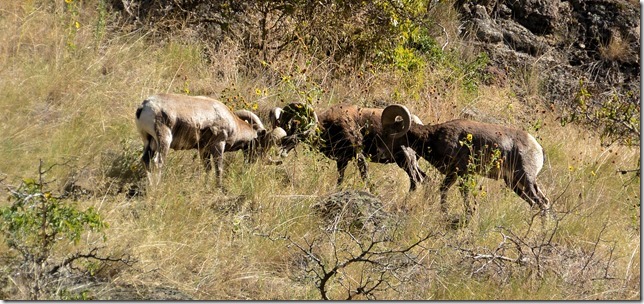
There’s a fantastic trail along the Snake, miles and miles of wild trekking that we really want to try some time.
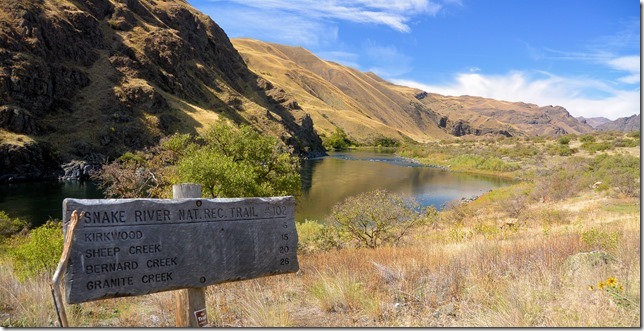
The entire area is formed from multiple layers of lava flows. It’s rough as a corn cob everywhere.
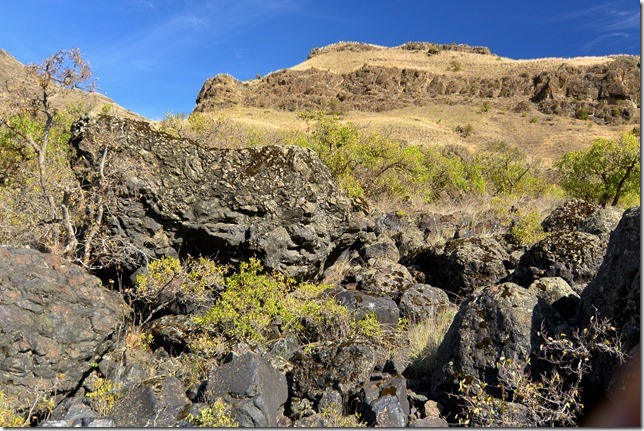
But where the River has worried and worn the rocks, the lava looks like polished clay – – – same rocks, lots more wear.
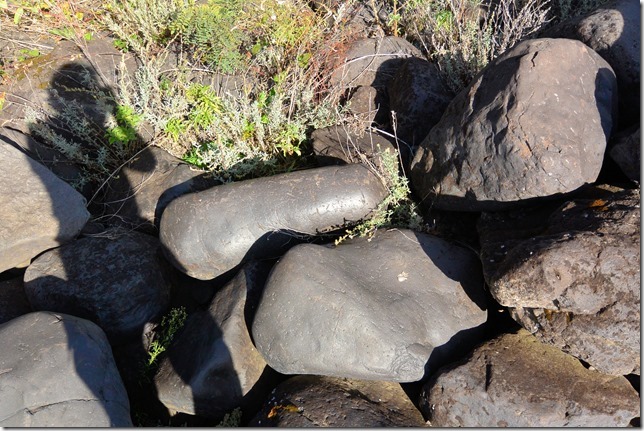
With what we saw of the Canyon on this side trip, we were determined to camp right on the Snake, so we studied the maps for quite a while to choose a destination. There are actually quite a few campgrounds, from elite to rugged, and as a beginning, we wanted to be close to the Hell’s Canyon Dam. The closest choice was one of the more “elite” camps, Hell’s Canyon Park. The “Park” series of camps are all on the Idaho side, and built and maintained by Idaho Power. Although they have the typical side-by-side arrangement of private parks, they’re done end-to-end (like parallel parking), which eases the proximity problem somewhat. They’re also cheap at $16, and they have these huge groomed lawn areas that make them feel more like city parks or golf courses than dusty RV lots. Add to all this that each site is 30 yards from the river, and well, we liked it quite a bit. We pumped up Bote and went for a smooth, relaxing paddle, exploring the reservoir and the shoreline shrubbery. There were massive rosebushes, all done up in rose-hips, walnut trees in full fruit, and the usual assortment of willows plus some cottonwoods. Delightful.
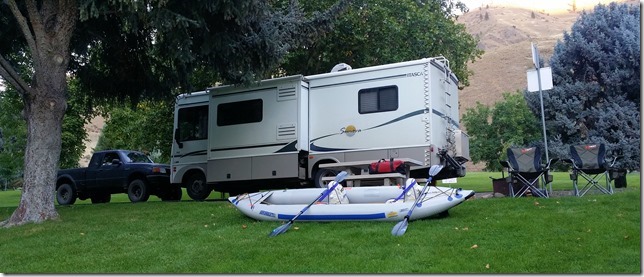
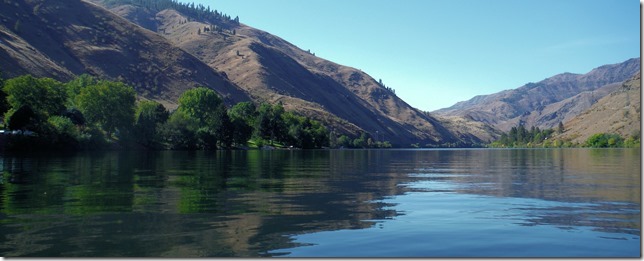
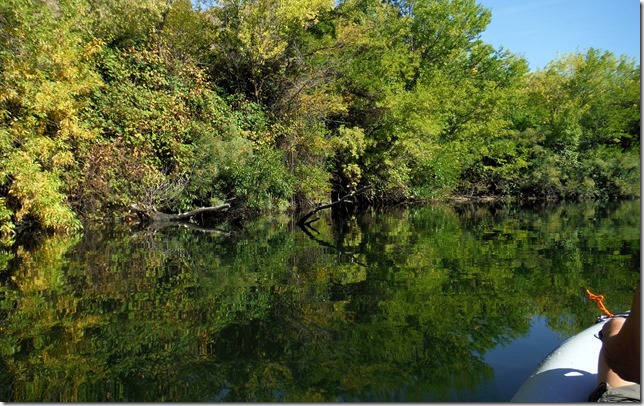
I should note that this section of the Canyon is vastly different from what early explorers found, due to the 3-dam system of reservoirs and power generators along the upper Snake. We camped on the farthest downstream unit, Hell’s Canyon Reservoir. About 20 more miles downstream is the last dam, Hell’s Canyon Dam, and the river runs “wild” after that. It was obvious to me that the multiple dams had extracted huge amounts of energy from the river, and the run from the dam to Pittsburgh Landing is probably only possible for people to do safely because of the virtual castration of the river. Oh well, things are the way they are. But it’s interesting to imagine the river in its original unmolested state. It must have been truly awesome to behold.
As it turned out, we left Bote inflated and paddled around the place many times, at least twice a day. But we still had some land-sightseeing to do, and we took Ralph way back up into the high country for a full day of exploring. (You can see our track at my InReach site)
Just north of the campground entrance is a rugged mountain road called Kleinschmidt Grade. It climbs precipitously up into the eastern side of Hell’s Canyon, with some nice views of our camp along the River.
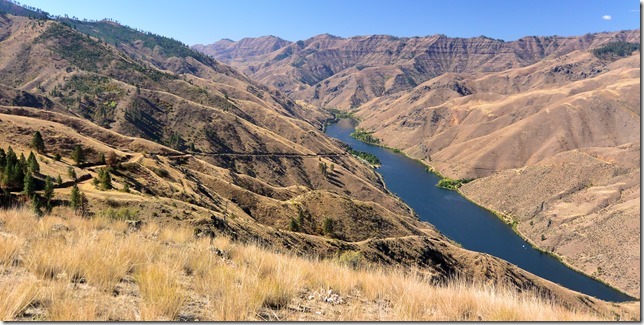
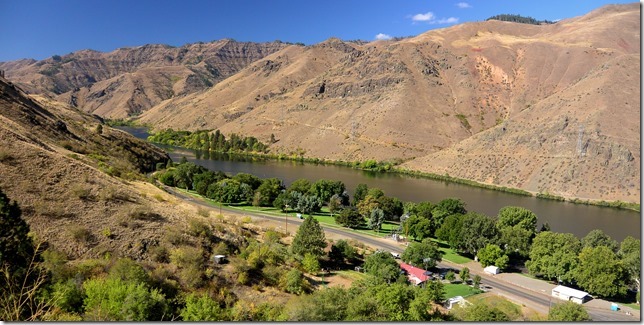
The road wound up through the forest and across several ridgelines, arriving eventually at the curious town of Cuprum. High in the mountains above the Hell’s Canyon, established through mining interests in 1909, and today still receiving mail service – – we were intrigued to say the least. A couple of old long-gray-beard codgers were sitting in rocking chairs on a front porch, calmly watching us roll by. Another “mountain man”, a skinny old man on a well-worn quad, scooted up beside us to ask if we were lost. We said no, just working our way up to Sheep Rock. “Take the next left, the sign’s gone missing”, was his friendly advice. We took it.
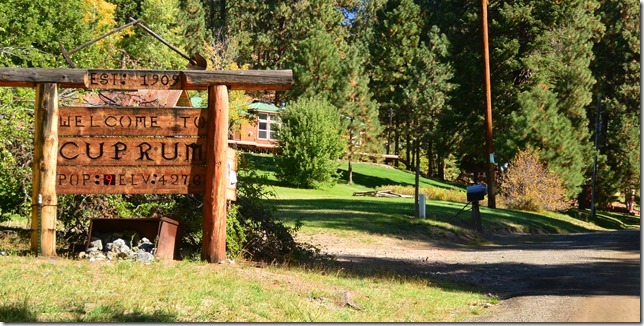
Cuprum has several varieties of lodging and structures, from the near-new sublime – – –
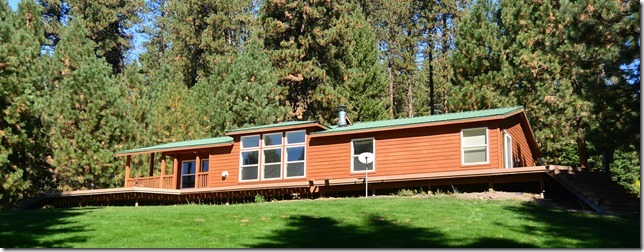
– – – to the last-century artifact. And lots in-between.
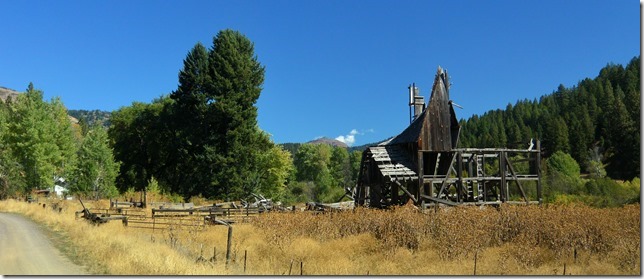
Even farther along, the road started to side-hill, frequently offering peeks back toward the Canyon. Higher and higher we went, with improving views with every turn.
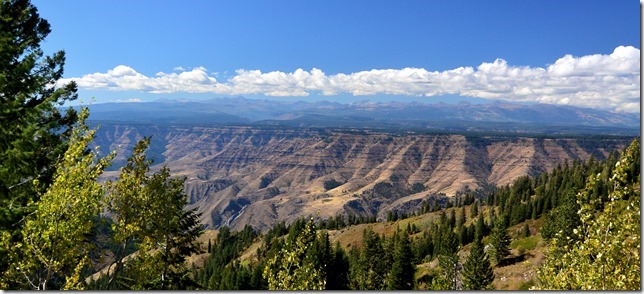
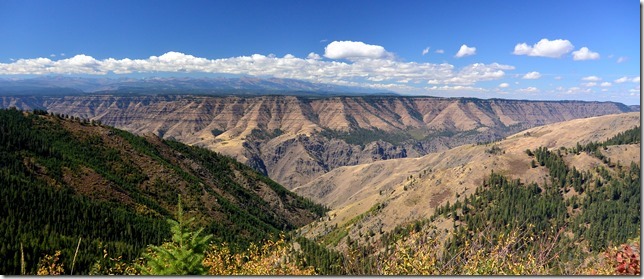
Eventually we arrived at the Sheep Rock overlook, a superbly selected spot from which to see the Canyon. A foot trail leads from a small parking area, and it’s possible to stand on a piece of lava and see the Snake and Hell’s Canyon for nearly 180 degrees, south-to-north. There is simply no way to photograph such splendor, but here are my pitiful snapshots – – –
South – – –
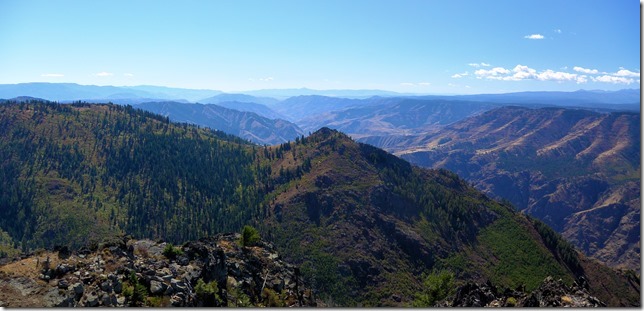
West – – –
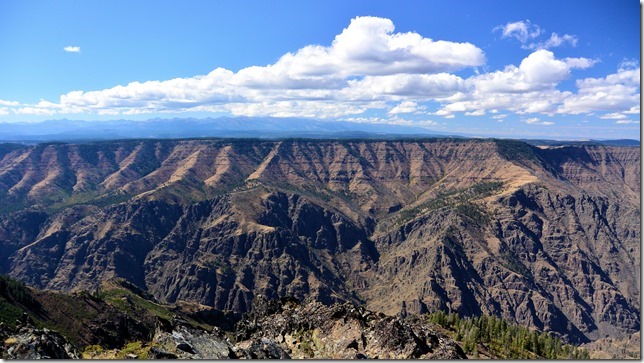
and North – – –
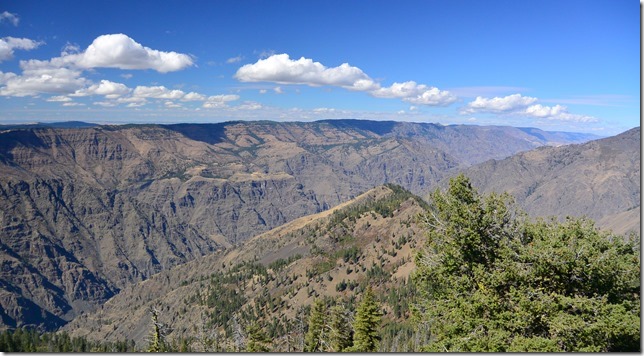
The drive down the mountain was as pleasant as going up, a 5,000 foot descent to the bottom of the river canyon. Camp was a delight, with the cool green grass, clear lake, and the lightest of gentle breezes to dapple the waters. An evening paddle prompted me to take one of my (thankfully few) un-smiling selfies. Hey, I was trying not to fall out of the boat, OK?
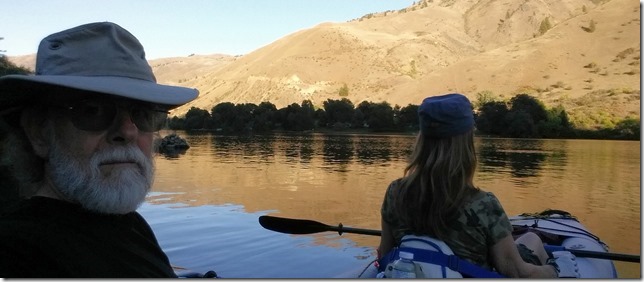
The next day called for heading over to fossil country – – – and that’s a different post.

Oh my beautiful America. I don’t tell people how nice it is here in Idaho. Otherwise it would be like California
Not to worry – – California’s crazy Democrats would never migrate to a self-reliant place like Idaho.
:o)
This was an outstanding report Greg… You and Karin are having a great time for all of us watching and reading. I personally love flying thru that area as both the Salmon and Snake rivers are so beautiful for viewing. Hoping you get to enjoy the Rogue River Canyon as you close in on Grants Pass. Make a stop in Agnes to say hi to the lady running the place on the river. Sadly, I can’t remember her name right now but I think it’s Julie. The airstrip is right there on the property. Good Luck and have fun!! Say hi to Karin for me!! She’s looking like she isn’t eating enough!! 😉
Weav